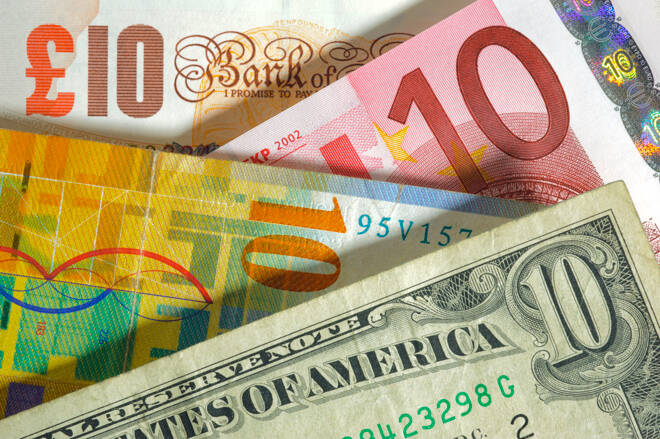Advertisement
Advertisement
A Busy Economic Calendar Puts the EUR, the Greenback, and the Loonie in Focus
By:
It's a busy day ahead on the economic calendar. Eurozone Inflation and GDP numbers will be in focus ahead of key stats from Canada and the U.S...
Earlier in the Day:
It was a busier start to the day on the economic calendar this morning. The Japanese and the Aussie Dollar were in action early in the Asian session.
For Japanese Yen
According to the Ministry of Internal Affairs and Communication, Tokyo’s core annual rate of inflation held steady at 0.1% versus a forecasted 0.3%.
Industrial production also disappointed, according to prelim figures. In September, industrial production fell by 5.4%, month-on-month. Production had fallen by 3.6% in August. Economists had forecast a 3.2% decline.
According to the Ministry of Economy, Trade and Industry,
Industries that contributed to the decrease were:
- Motor vehicles.
- General purpose and business orientated machinery.
- Plastic products.
Industries that contributed to the increase were:
- Inorganic and organic chemicals.
- Chemicals (excl. inorganic and organic chemicals, and medicine).
- Petroleum and coal products.
The Japanese Yen moved from ¥113.562 to ¥113.583 upon release of the figures. At the time of writing, the Japanese Yen was up by 0.03% to ¥113.440 against the U.S Dollar.
For the Aussie Dollar
Wholesale inflation and retail sales were in focus this morning.
In the 3rd quarter, the annual rate of wholesale inflation picked up from 2.2% to 2.9%.
Quarter-on-quarter, the producer price index rose by 1.1% after having risen by 0.7% in the previous quarter.
Of greater significance, however, were prelim retail sales figures. In September, retail sales increased by 1.3% after having declined by 1.7% in August. Economists had forecast a 0.2% rise.
According to the ABS,
- Retail sales increased for the first time since May 2021, with Queensland recording the largest increase in sales ever (+5.2%).
- New South Wales saw sales increase 2.3% in spite of lockdown measures being in place.
- By contrast, Victoria and the Australian Capital Territory saw further declines in sales, with lockdown measures continuing to bite.
- Household goods (+4.3%) and cafes, restaurants, and takeaway food services (5.0%) sales led the way.
- There were also increases in sales in other retailing (+2.1%) and clothing, footwear, and personal accessories (+5.9%).
From the RBA, private sector credit figures had a muted impact, however. In September, private sector credit rose by 0.6% versus a forecasted 0.6%. Private sector credit had increased by 0.6% in August.
The Aussie Dollar moved from $0.75324 to $0.75341 upon release of the figures. At the time of writing, the Aussie Dollar down by 0.24% to $0.7526.
Elsewhere
At the time of writing, the Kiwi Dollar was down by 0.37% to $0.7174.
The Day Ahead
For the EUR
It’s another busy day ahead on the economic calendar. 3rd quarter GDP and inflation figures are due out later today.
GDP numbers for France, Germany, and the Eurozone together with prelim October inflation figures for the Eurozone will be the key numbers.
At the time of writing, the EUR was up by 0.02% to $1.1683.
For the Pound
It’s yet another quiet day ahead on the economic calendar. House price figures are due out later today that should have a muted impact on the Pound.
At the time of writing, the Pound was flat at $1.3790.
Across the Pond
It’s another busy day ahead. Personal spending and inflation figures are due out along with Chicago PMI and consumer sentiment figures.
Barring any marked revisions to consumer sentiment numbers, the inflation and personal spending data will be key.
At the time of writing, the U.S Dollar Spot Index was up by 0.02% to 93.361.
For the Loonie
It’s a relatively busy day ahead for the Loonie. GDP and RMPI numbers are due out later today.
From the numbers, expect the GDP figures for August to have the greatest impact on the Loonie.
At the time of writing, the Loonie was down by 0.12% to C$1.2361 against the U.S Dollar.
For a look at all of today’s economic events, check out our economic calendar.
About the Author
Bob Masonauthor
With over 28 years of experience in the financial industry, Bob has worked with various global rating agencies and multinational banks. Currently he is covering currencies, commodities, alternative asset classes and global equities, focusing mostly on European and Asian markets.
Advertisement
